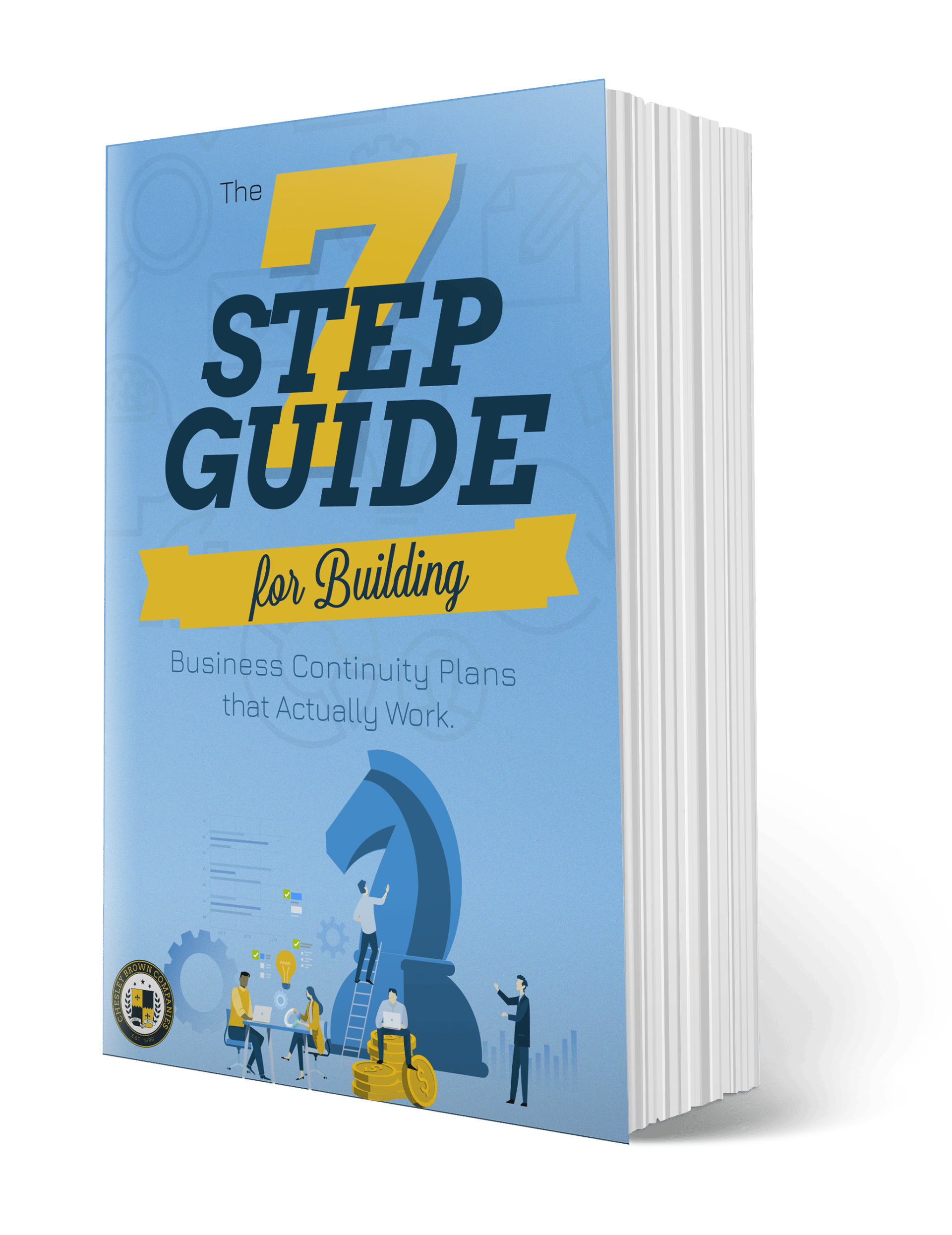Ensure the Future of Your Company
Small to medium-sized enterprises (SMEs) comprise a massive portion of American industry. In fact, 99% of all businesses have less than 500 employees; 98% of them have fewer than 100, and small businesses drive nearly 50% of all America’s non-agrarian GDP. SMEs drive our economy.
0%
of all businesses have fewer than 500 employees0%
of all COVID-related closures will be permanent0%
of America's GDP is driven by SMEsNevertheless, SMEs are vulnerable to crises. In the spring of 2020, thanks to the worldwide Coronavirus pandemic, we came to realize just how at-risk our small businesses are. Many organizations paused operations and for some, there was no plan in place to deal with this unprecedented event costing U.S. businesses an average of $336,000 per hour of downtime, according to Gartner. A more recent report (from Ponemon Institute in 2016) raises Gartner’s average from $5,600 per minute to nearly $9,000 per minute.
For small businesses, that number drops to the lower, but still significant, tune of $137 to $427 per minute. And where your company falls on this very wide spectrum depends on a number of factors, including industry vertical, organization size, and business model. According to some statistics businesses who don't reopen 5 days after a crisis, close their doors forever.
Since the onset of the Covid-19 pandemic, small businesses have struggled to keep their doors open, with an estimated 60% closing permanently following an initial closure due to the virus. Yet, many of the 30 million small businesses and 20 million self-employed gig workers have managed to not only survive this economic calamity, but have thrived.
What gives? How did they do it?
What strategies can your business adopt to ensure a sustainable future?
3 Keys to Weathering a Crisis for Small Businesses
1. Be Nimble
Remember the story of David and Goliath? Briefly, Goliath was a huge, imposing fellow, sure to crush the miniscule David. Yet, David triumphed, leveraging his ingenuity to build a sling-shot and defeat his sizable foe. While this may not be the perfect analogy, we can learn something from it.
SMEs lack the resources of large corporations, but they have a notable advantage–a small footprint allows them to rapidly adapt and pivot in response to an uncertain economic landscape.
Think laterally. By considering non-traditional avenues of product and service delivery, many SME’s have managed to thrive during the pandemic. For example, the most successful restaurant owners quickly adapted their business strategy to a take-out model, ensuring customer and employee safety by avoiding unnecessary contact. Experimenting with readily available tools can be a sure fire way to drive innovation for minimal cost, as many businesses did with online ordering systems, payment gateways, and digital experiences. By adapting and showing an openness to innovate, you are likely to open your business up to new revenue streams.
For instance, Chesley Brown CEO Brent Brown, describes a situation in which a friend who owns a hospitality company and manages private clubs had to shut down many of them due to the restrictions due to the pandemic. The stakeholders didn’t believe that operations would be able to resume for a year or more. They were right. So they pivoted, purchasing a large landscaping company to add to their portfolio. As owners of a golf course, landscaping is a major component of their daily operations, and despite appearances, it made sense to go lateral and expand what they already knew.
Many SME’s have managed to survive the Covid-19 Pandemic by adapting to a rapidly changing economic landscape. Adaptability is an essential component to any SME’s crisis response.
2. Involve Your Community
Human beings are social creatures. We rely on our relationships to build resilient, durable networks able to withstand the stressors of day-to-day life. Thus, social relationships are essential for survival–the same goes for our businesses: in order to navigate the unpredictability of the social and economic landscape, you need to forge connections with the members of your community, including its citizens, non-profit organizations, universities, and fellow SMEs.
Start by defining your organization’s role in the community context by understanding three fundamental facets of your business:
-
Products and Services
How does your organization contribute to the well-being of community members? Understand how the crisis impacts people in the community and how your products and services can help them through it.
-
Jobs Provided
How many jobs do you provide to the community? What would happen if these jobs were not available? Taking time to understand the role your business plays in the community’s economic vitality and to communicate that message with clarity can have a profound impact on how the community perceives your business.
-
Community Outreach
Is your business actively involved in community outreach? By involving your business in fundraising events and charities for local causes, you are forging new relationships with people and businesses who will be willing to provide assistance when you need it the most.
During the Covid outbreak, a number of SMEs seized the opportunity to adapt their business models and in turn, provide services to those most in need. For example, a Pennsylvania catering service began donating meals to essential workers. This serves two functions: first, it positions the business as a vital element contributing to the community’s health and well-being, and also, raises publicity by drawing attention to the company’s willingness to be of service, thereby earning brand trust in the eyes of customers.
By highlighting the role your business serves in the context of your community, you strengthen your image, build networks, and establish a support network.
But how can you afford to keep your doors open without customers?
3. Identify Financial Resources
Businesses need capital. It’s essential for everything they do. Employees need paychecks and supplies need replenished. So it’s surprising that on average, SMEs only have 1 – 4 weeks of cash reserves. In other words, they have enough capital to keep their doors open between a week and a month should a crisis strike. This does not bode well for a company’s future.
Luckily, there are simple solutions to this problem:
- Save – How can you save more money without hurting your bottom line or cutting employee hours? Generate innovative solutions for bolstering revenue and put the extra money in a savings account. Can you host an open-mic night once a week or cater for weddings on the weekend? Identify a secondary service with low overhead cost and use it to generate discretionary income, and put that money in an savings account.
- Build relationships with financial institutions – Take advantage of loan programs offered by local and national financial institutions. Get to know the inner workings of these programs and reach out to loan officers to develop a financial plan. The more informed you are about current financial offerings, the better positioned you are to take advantage of them.
- Monitor financial technology companies – During the pandemic, many financial tech companies are offering their services at a lower cost to help SMEs. For instance, one well-known remote payment service has waved their transaction fees for small businesses during the pandemic. Thus, SMEs can now offer socially distanced payment options without shouldering a financial burden.
- Take advantage of state and federal assistance – State and federal governments offer loans and grants to help SMEs through the pandemic. For example, the Paycheck Protection Program (PPP) is a federal loan incentivizing SMEs by offering loan forgiveness if they are able to keep employees on the payroll.
- Keep the supply chain open – The Coronavirus Pandemic made it clear that supply chain disruptions are a real possibility. During the initial weeks of the pandemic, widespread shortages in paper goods, disinfectants, and food supplies were prevalent. Thus, it’s essential that you remain vigilant, consulting with suppliers and planning for potential crises. Additionally, in the event of a shortage, consider unconventional ways to restock your supplies. For instance, many business owners began producing their own alcohol based sanitizing wipes due to shortages in commercial sanitizers.
- Recognize hidden opportunities for growth – Compared to large corporations, SMEs are more likely to fail under the weight of economic uncertainty and thus, require greater ingenuity and innovation to remain viable. When planning for how to prepare for economic risk, continuously reassess every operational component of your enterprise and recognize growth indicators. For instance, solicit feedback from regular customers; questions about additional products, new services, or advice on ancillary issues signal growth opportunities. Internal factors like sustained profit growth, industry consolidation, and digital transformation may also play a major factor in deciding whether or not to expand.
Conclusion:
Do your research and familiarize yourself with the people, programs, and resources available to help your company through this crisis. Make a cut sheet of each resource covering Who, What, When, Where, How and Why, and keep it available.
Know your priorities and take care of the most essential elements of your business first–are your employees safe and secure, is your rent paid, and are your supplies stocked? Are you losing money on sectors of your business that are draining your finances?
“Don’t fall in love with your product…If it’s not making sense financially, you’ve got to drop back and reassess” – Brent Brown, CEO of Chesley Brown International
Remember: planning is essential. You could save thousands in lost revenue and guarantee that you’ll never close your doors by having a crisis management plan in place. Start planning today, consider business risks associated with the Covid-19 Pandemic.
And remember, you are not alone. For more information on how we can help protect your business, let’s talk.Stay tuned: Next week we will discuss the importance of conducting a threat assessment.
Subscribe!
For industry-leading tips and analysis sign up for our blog below.
Latest News
Lessons Businesses Must Learn from the Nashville Bombing
The sound of gunfire punctuated the peaceful hush of Christmas morning. According to one witness, “It sounded like an automatic weapon.” About 10 minutes later she heard a second round of gunfire, then a third.…
Read More3 Simple Practices to Optimize School Safety During Covid-19
Maximizing safety for students and employees If you’re anything like me, keeping your family safe is your number one priority. During the Covid-19 pandemic, this means minimizing social contact to reduce the chances of infection. …
Read More4 Crucial Things To Know About Business Impact Analysis
Risk is not optional. If you own a business, chances are, you will confront risks at some point. What’s more, as your business grows, potential business disruptions will increase in both frequency and harm potential.…
Read More2 Painless Ways to Transition Your Retail Business to Touchless Technology
Why your business should be transitioning to touchless tech right now As a business owner in the retail industry, adjusting to the Covid-19 pandemic is a huge challenge. Nevertheless, you’ve crossed your t’s and dotted…
Read More3 Overlooked Tips to Destress During the Holidays
Bring home holiday gifts without the baggage It’s that time of the year. Some would say the most wonderful time. But for others, the lights and tinsel of the holidays evoke strong memories of the…
Read More







